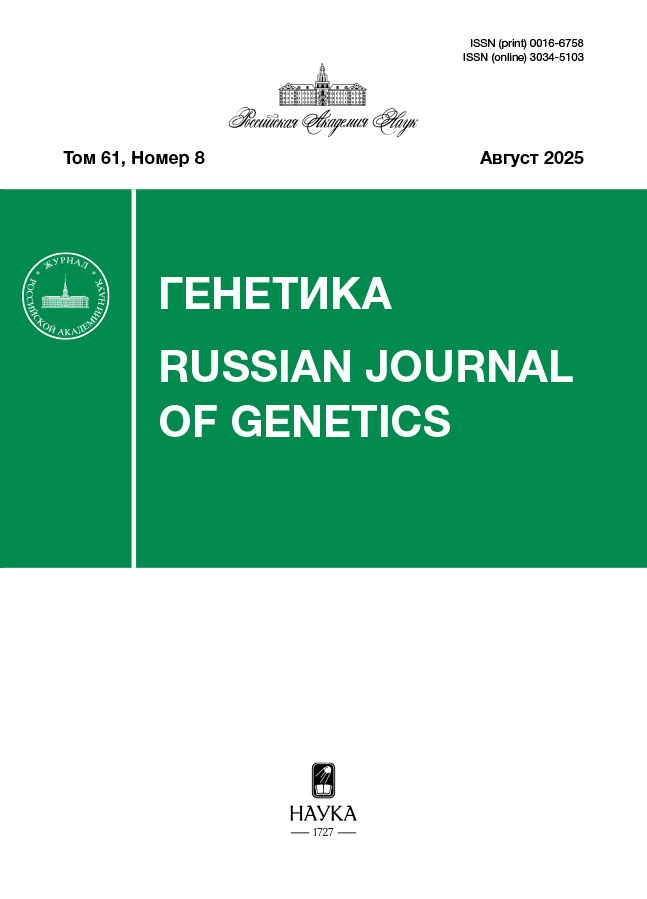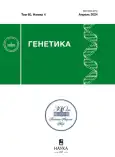Полиморфизм генов Толл-подобных рецепторов в выборке больных ВИЧ-инфекцией и туберкулезом из стран Восточной Европы и Центральной Азии
- Авторы: Саламайкина С.А.1,2, Корчагин В.И.1, Миронов К.О.1, Кулабухова Е.И.1,3, Зимина В.Н.4, Кравченко А.В.1
-
Учреждения:
- Центральный научно-исследовательский институт эпидемиологии Федеральной службы по надзору в сфере защиты прав потребителей и благополучия человека
- Московский физико-технический институт
- Российский университет дружбы народов
- Кемеровский государственный медицнский университет
- Выпуск: Том 60, № 4 (2024)
- Страницы: 84-93
- Раздел: ГЕНЕТИКА ЧЕЛОВЕКА
- URL: https://rjsvd.com/0016-6758/article/view/666951
- DOI: https://doi.org/10.31857/S0016675824040071
- EDN: https://elibrary.ru/crdrpp
- ID: 666951
Цитировать
Полный текст
Аннотация
Полиморфные варианты генов иммунного ответа могут быть ассоциированы с особенностями реакции организма на инфекционные агенты и вносят вклад в генетическое разнообразие популяций человка. В настоящем исследовании проведен сравнительный анализ частот аллелей и генотипов полиморфных вариантов генов Толл-подобных рецепторов TLR1, TLR2, TLR4, TLR6 и TLR8 в выборках пациентов с ВИЧ и туберкулезом, проживающих на территории стран Восточной Европы и Центральной Азии. В исследование включено 680 неродственных индивидов из восточнославянской (n = 308), армянской (n = 137), таджикской (n = 138) и киргизской (n = 97) выборок пациентов с установленными диагнозами ВИЧ и туберкулез. Для сравнения использованы данные международного проекта 1000 Genomes – выборки европеоидов (EUR) и представителей стран Восточной (EAS) и Южной (SAS) Азии. Обнаружено, что, несмотря на низкий уровень генетического разнообразия и межпопуляционных различий по частотам аллелей анализируемых генов, исследуемые выборки тем не менее различались по ряду локусов между собой и отличались как от популяций европеоидов, так и от жителей стран Восточной и Южной Азии.
Полный текст
Об авторах
С. А. Саламайкина
Центральный научно-исследовательский институт эпидемиологии Федеральной службы по надзору в сфере защиты прав потребителей и благополучия человека; Московский физико-технический институт
Автор, ответственный за переписку.
Email: salamaykina@cmd.su
национальный исследовательский университет
Россия, Москва, 111123; Московская область, Долгопрудный, 141701В. И. Корчагин
Центральный научно-исследовательский институт эпидемиологии Федеральной службы по надзору в сфере защиты прав потребителей и благополучия человека
Email: salamaykina@cmd.su
Россия, Москва, 111123
К. О. Миронов
Центральный научно-исследовательский институт эпидемиологии Федеральной службы по надзору в сфере защиты прав потребителей и благополучия человека
Email: salamaykina@cmd.su
Россия, Москва, 111123
Е. И. Кулабухова
Центральный научно-исследовательский институт эпидемиологии Федеральной службы по надзору в сфере защиты прав потребителей и благополучия человека; Российский университет дружбы народов
Email: salamaykina@cmd.su
Россия, Москва, 111123; Москва, 117198
В. Н. Зимина
Кемеровский государственный медицнский университет
Email: salamaykina@cmd.su
Россия, Кемерово, 650056
А. В. Кравченко
Центральный научно-исследовательский институт эпидемиологии Федеральной службы по надзору в сфере защиты прав потребителей и благополучия человека
Email: salamaykina@cmd.su
Россия, Москва, 111123
Список литературы
- Саламайкина С.А., Миронов К.О. Однонуклеотидные полиморфизмы генов толл-подобных рецепторов, ассоциированные с риском развития туберкулеза и другими заболеваниями нижних дыхательных путей // Эпидемиология и инфекционные болезни. Актуальные вопросы. 2023. Т. 4. С. 57–61.
- Naderi M., Hashemi M., Mirshekari H. et al. Toll-like receptor 1 polymorphisms increased the risk of pulmonary tuberculosis in an iranian population sample // BES. 2016. V. 29. № 11. P. 825–828. https://doi.org/10.3967/bes2016.110
- Thompson C.M., Holden T.D., Rona G. et al. Toll-like receptor 1 polymorphisms and associated outcomes in sepsis after traumatic injury: А candidate gene association study // Annals of Surgery. 2014. V. 259. № 1. P. 179–185. https://doi.org/10.1097/SLA.0b013e31828538e8
- Schurz H., Daya M., Möller M. et al. TLR1, 2, 4, 6 and 9 variants associated with tuberculosis susceptibility: А systematic review and meta-analysis // PLoS One. 2015. V. 10. https://doi.org/10.1371/journal.pone.0139711
- Gao J., Zhang A., Wang X. et al. Association between the TLR2 Arg753Gln polymorphism and the risk of sepsis: a meta-analysis // Critical Care. 2015. V. 19. № 1. P. 416. https://doi.org/10.1186/s13054-015-1130-3
- Ferwerda B., Kibiki G., Netea M. et al. The Toll-like receptor 4 Asp299Gly variant and tuberculosis susceptibility in HIV-infected patients in Tanzania // AIDS. 2007. V. 21. № 10. P. 1375–1377. https://doi.org/10.1097/QAD.0b013e32814e6b2d
- Pulido I., Leal M., Genebat M. et al. The TLR4 ASP299GLY polymorphism is a risk factor for active tuberculosis in Caucasian HIV-infected patients // Curr. HIV Res. 2010. V. 8, № 3. P. 253–258. https://doi.org/10.2174/157016210791111052
- Wang C.-H., Eng H.-L., Lin K.-H. et al. Functional polymorphisms of TLR8 are associated with hepatitis C virus infection // Immunology. 2014. V. 141. № 4. P. 540–548. https://doi.org/10.1111/imm.12211
- El-Bendary M., Neamatallah M., Elalfy H. et al. The association of single nucleotide polymorphisms of Toll-like receptor 3, Toll-like receptor 7 and Toll-like receptor 8 genes with the susceptibility to HCV infection // British J. Biomedical Science. 2018. V. 75. № 4. P. 175–181. https://doi.org/10.1080/09674845.2018.1492186
- Davila S., Hibberd M., Hari Dass R. et al. Genetic association and expression studies indicate a role of Toll-like receptor 8 in pulmonary tuberculosis // PLoS Genet. 2008. V. 4. № 10. https://doi.org/10.1371/journal.pgen.1000218
- Varzari A., Deyneko I., Vladei I. et al. Genetic variation in TLR pathway and the risk of pulmonary tuberculosis in a Moldavian population // Infection, Genetics and Evolution. 2019. V. 68. P. 84–90. https://doi.org/10.1016/j.meegid.2018.12.005
- Dalgic N., Tekin D., Kayaalti Z. et al. Relationship between Toll-like receptor 8 gene polymorphisms and pediatric pulmonary tuberculosis // Disease Markers. 2011. V. 31. № 1. P. 33–38. https://doi.org/10.3233/DMA-2011-0800
- Ugolini M., Gerhard J., Burkert S. et al. Recognition of microbial viability via TLR8 drives TFH cell differentiation and vaccine responses // Nat. Immunol. 2018. V. 19. № 4. P. 386–396. https://doi.org/10.1038/s41590-018-0068-4
- Selvaraj P., Harishankar M., Singh B. et al. Toll-like receptor and TIRAP gene polymorphisms in pulmonary tuberculosis patients of South India // Tuberculosis. 2010. V. 90. № 5. P. 306–310. https://doi.org/10.1016/j.tube.2010.08.001
- Harishankar M., Selvaraj P., Bethunaickan R. Influence of genetic polymorphism towards pulmonary tuberculosis susceptibility // Front. Med. 2018. V. 5. https://doi.org/10.3389/fmed.2018.00213
- The 1000 Genomes Project Consortium et al. A global reference for human genetic variation // Nature. 2015. V. 526. № 7571. P. 68–74. https://doi.org/10.1038/nature15393
- Machiela M.J., Chanock S.J. LDlink: A web-based application for exploring population-specific haplotype structure and linking correlated alleles of possible functional variants // Bioinformatics. 2015. V. 31. № 21. P. 3555–3557. https://doi.org/10.1093/bioinformatics/btv402
- 18. dbSNP Summary [электронный ресурс]. URL: https://www.ncbi.nlm.nih.gov/projects/SNP/snp_summary.cgi (accessed: 05.10.2023).
- Salamaikina S., Korchagin V., Kulabukhova E. et al. Association of Toll-like receptor gene polymorphisms with tuberculosis in HIV-positive participants // Epigenomes. 2023. V. 7. № 3. https://doi.org/10.3390/epigenomes7030015
- Graffelman J. Exploring diallelic genetic markers: the Hardy–Weinberg package // J. Stat. Soft. 2015. V. 64. № 3. https://doi.org/10.18637/jss.v064.i03
- Kamvar Z.N., Tabima J.F., Grünwald N.J.Poppr : An R package for genetic analysis of populations with clonal, partially clonal, and/or sexual reproduction // Peer.J. 2014. V. 2. https://doi.org/10.3389/fgene.2015.00208
- Jombart T. adegenet : A R package for the multivariate analysis of genetic markers // Bioinformatics. 2008. V. 24. № 11. P. 1403–1405. https://doi.org/10.1093/bioinformatics/btn129
- Jombart T., Ahmed I.adegenet 1.3-1: New tools for the analysis of genome-wide SNP data // Bioinformatics. 2011. V. 27. № 21. P. 3070–3071. https://doi.org/10.1093/bioinformatics/btr521
- Winter D.J. mmod: An R library for the calculation of population differentiation statistics // Mol. Ecol. Resources. 2012. V. 12. № 6. P. 1158–1160. https://doi.org/10.1111/j.1755-0998.2012.03174.x
- Serrote C.M.L., Reiniger L., Silva K.B. et al. Determining the polymorphism information content of a molecular marker // Gene. 2020. V. 726. https://doi.org/10.1016/j.gene.2019.144175
- Nei M. Molecular evolutionary genetics // Molecular Evolutionary Genetics. Columbia Univ. Press, 2019.
- Nei M., Chesser R.K. Estimation of fixation indices and gene diversities // Ann. Human. Genet. 1983. V. 47. № 3. P. 253–259. https://doi.org/10.1111/j.1469-1809.1983.tb00993.x
- Kushniarevich A., Sivitskaya L., Danilenko N. et al. Uniparental genetic heritage of Belarusians: encounter of rare Middle Eastern matrilineages with a Central European mitochondrial DNA pool // PLoS One. 2013. V. 8. № 6. https://doi.org/10.1371/journal.pone.0066499
- Roewer L., Willuweit S., Krüger C. et al. Analysis of Y chromosome STR haplotypes in the European part of Russia reveals high diversities but non-significant genetic distances between populations // Int. J. Legal. Med. 2008. V. 122. № 3. P. 219–223. https://doi.org/10.1007/s00414-007-0222-2
- Weale M.E., Yepiskoposyan L., Jager R. et al. Armenian Y chromosome haplotypes reveal strong regional structure within a single ethno-national group // Hum. Genet. 2001. V. 109. № 6. P. 659–674. https://doi.org/10.1007/s00439-001-0627-9
- Yepiskoposyan L., Hovhannisyan A., Khachatryan Z. Genetic structure of the Armenian population // Arch. Immunol. Ther. Exp. 2016. V. 64. № 1. P. 113–116. https://doi.org/10.1007/s00005-016-0431-9
- Heyer E., Balaresque P., Jobling M. et al. Genetic diversity and the emergence of ethnic groups in Central Asia // BMC Genetics. 2009. V. 10. № 1. https://doi.org/10.1186/1471-2156-10-49
- Xing J., Watkins W., Shlien A. et al. Toward a more uniform sampling of human genetic diversity: A survey of worldwide populations by high-density genotyping // Genomics. 2010. V. 96. № 4. P. 199–210. https://doi.org/10.1016/j.ygeno.2010.07.004
- Guarino-Vignon P., Marchi N., Bendezu-Sarmiento J. et al. Genetic continuity of Indo-Iranian speakers since the Iron Age in southern Central Asia // Sci. Rep. 2022. V. 12. № 1. P. 733. https://doi.org/10.1038/s41598-021-04144-4
- Palstra F.P., Heyer E., Austerlitz F. Statistical inference on genetic data reveals the complex demographic history of human populations in Central Asia // Mol. Biol. and Evolution. 2015. V. 32. № 6. P. 1411–1424. https://doi.org/10.1093/molbev/msv030
- Martínez-Cruz B., Vitalis R., Ségurel L. et al. In the heartland of Eurasia: The multilocus genetic landscape of Central Asian populations // Eur. J. Hum. Genet. 2011. V. 19. № 2. P. 216–223. https://doi.org/10.1038/ejhg.2010.153
- Narasimhan V.M., Patterson N., Moorjani P. et al. The formation of human populations in South and Central Asia // Science. 2019. V. 365. № 6457. https://doi.org/10.1126/science.aat7487
- Zhou Y., Zhang M. Associations between genetic polymorphisms of TLRs and susceptibility to tuberculosis: A meta-analysis // Innate Immun. 2020. V. 26. № 2. P. 75–83. https://doi.org/10.1177/1753425919862354
- Кулабухова Е.И., Миронов К.О., Дунаева Е. А. и др. Ассоциация полиморфизмов в генах Toll-подобных рецепторов и маннозосвязывающего лектина с риском развития туберкулеза у пациентов с ВИЧ-инфекцией // ВИЧ-инфекция и иммуносупрессии. 2020. Т. 11. № 4. С. 61–69. https://doi.org/10.22328/2077-9828-2019-11-4-61-69
- Martin A.R., Gignoux C., Walters R. et al. Human demographic history impacts genetic risk prediction across diverse populations // Am. J. Hum Genet. 2017. V. 100. № 4. P. 635–649. https://doi.org/10.1016/j.ajhg.2017.03.004
- Peterson R.E., Kuchenbaecker K., Walters R. et al. Genome-wide association studies in ancestrally diverse populations: opportunities, methods, pitfalls, and recommendations // Cell. 2019. V. 179. № 3. P. 589–603. https://doi.org/10.1016/j.cell.2019.08.051
Дополнительные файлы












